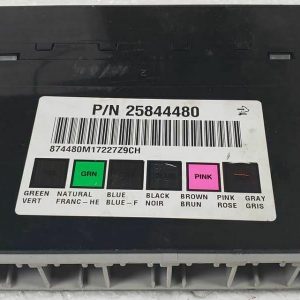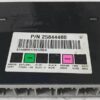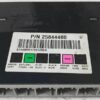Fix Your Truck’s Electrical Headaches for Good
If you’re dealing with a 2013 GMC Sierra 3500 that seems to have a mind of its own—with flickering lights, a dead HVAC system, or power windows that won’t cooperate—you’re likely facing a failing Body Control Module (BCM). As the central command center for your truck’s body electronics, a faulty BCM can cause a cascade of frustrating and seemingly unrelated problems. This OEM-quality replacement, part number 25835966, is the definitive solution. We pre-program it to your truck’s specific VIN, so it arrives ready for a true plug-and-play installation, restoring full functionality without a trip to the dealership.
Case Study: The Ghost in the Machine
A customer brought in a 2011 Silverado 2500 with a textbook “haunted” vehicle problem. The radio would turn on and off, the dome light would stay on, and the security light was flashing, causing intermittent no-start conditions. They had already replaced the battery and checked the alternator. After hooking up my scanner, I saw a dozen communication codes pointing everywhere. From years of experience, I knew to check the BCM ground first—it was solid. The issue was the BCM itself. Its internal logic was failing, sending erratic signals across the CAN bus network. Installing a VIN-programmed 2013 Sierra 3500 BCM (the same family of modules) solved every single issue instantly. This is a classic example of how one module can create system-wide chaos.
Is Your GM Truck Showing These Symptoms?
A failing BCM doesn’t always throw a clear check engine light. Instead, it manifests as a collection of bizarre electrical issues. Here’s what to look for:
- ✔ Power windows, door locks, or mirrors working intermittently or not at all.
- ✔ HVAC controls are unresponsive, or the blower motor is stuck on or off.
- ✔ The security system acts up, causing no-start conditions or false alarms.
- ✔ An airbag warning light is illuminated, often with a DTC like B1001 (Setup SDM Primary Key in BCM).
- ✔ Headlights, taillights, or interior lights flicker, stay on, or won’t turn on.
- ✔ Erratic behavior from the windshield wipers.
A Straightforward Guide to Installation
For most DIYers and professional mechanics, this is a quick and simple job. You can have your truck back to normal in minutes.
- Safety First: Always disconnect the negative terminal from your vehicle’s battery before working on electrical components.
- Locate the BCM: On most GM trucks and SUVs of this era, the BCM is located under the driver’s side of the dashboard, near the steering column. It’s a black box with several large multi-pin connectors.
- Remove the Old Module: Carefully unplug the electrical connectors. They have locking tabs that need to be depressed. Once unplugged, the module can be unclipped or unbolted from its mounting bracket.
- Install the New BCM: Seat the new, VIN-programmed module into the bracket and firmly reconnect all electrical harnesses. Ensure each one clicks securely into place.
- Reconnect and Test: Reconnect the negative battery terminal. Start the vehicle and test all functions: lights, locks, windows, HVAC, and wipers to confirm the repair.
- Post-Install Checks: In some cases, an airbag light may persist. This requires an advanced scan tool to perform the ‘Setup SDM Primary Key in BCM’ function. A ‘Brake Pedal Position Relearn’ may also be needed.
Why Choose a VIN-Programmed Module?
This isn’t just a generic part. We take your vehicle’s VIN and flash the module with the latest GM software specific to your truck’s options and features. This crucial step ensures your new 2013 Sierra 3500 BCM communicates perfectly with the Powertrain Control Module (PCM), anti-lock brake system, and other critical computers on your vehicle. It eliminates the need for expensive dealer-only programming tools, saving you hundreds of dollars and significant downtime. This module is a reliable, long-term fix, not a temporary patch.
Verified Vehicle Compatibility for Your GM Truck or SUV
This Body Control Module is a direct replacement for part number 25835966 and other interchangeable numbers on a wide range of 2007-2013 General Motors trucks and SUVs. It is guaranteed to fit the following models, but always verify your part number for a perfect match:
- GMC Sierra / Sierra Denali (1500, 2500, 3500): 2007-2013
- Chevrolet Silverado (1500, 2500, 3500): 2007-2013
- Chevrolet Avalanche: 2007-2013
- Chevrolet Suburban / Tahoe: 2007-2013
- GMC Yukon / Yukon XL: 2007-2013
- Cadillac Escalade / ESV / EXT: 2007-2013
This module is also a direct replacement for part numbers: 15263363, 15263497, 15878753, 15284816, 15943678, 15926094, 15940214, 25790508, 25790509, 25823558, 25823559, 25835965, 25844479, 25971916, 25971917, 15901388, 20939137, 20939138, 22860591.
Frequently Asked Questions
What does ‘VIN Programmed’ actually mean?
It means we load the module with the specific software and settings for your exact vehicle using your 17-digit Vehicle Identification Number (VIN). This makes the part plug-and-play, so it works correctly with your truck’s options (like power seats, specific lighting, etc.) right out of the box.
Do I need to send my old BCM back?
No, there is absolutely no core charge for this part. You can keep your old module or dispose of it responsibly without any extra fees or hassle.
My airbag light is on. Will this fix it?
A faulty BCM is a very common cause for an airbag light with DTC B1001. Replacing it often resolves the issue. However, after installation, you may need a professional scan tool to perform the ‘Setup SDM Primary Key in BCM’ procedure to sync the modules and clear the light.
Is this a difficult part for a DIYer to install?
Not at all. For most people with basic tools, this is a 10-15 minute job. The module is typically easy to access under the dashboard, and the connectors are simple to unplug and reconnect.
Will this fix my truck’s no-start problem?
It can. The BCM is a key part of the vehicle’s anti-theft and security system. If it fails, it can prevent the engine from starting. If your no-start issue is combined with other electrical symptoms, a faulty BCM is a likely culprit.



